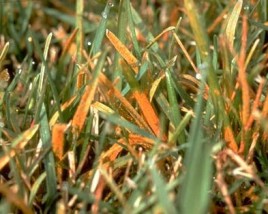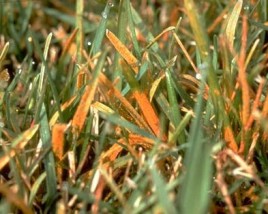How Did THAT Get In My Lawn: Lawn Rust

Living in the Philadelphia metro-area, you understand that you’re going to have to deal with certain lawn care issues, diseases and even lawn rust. With the last two summers resulting in uncharacteristic like trends and plenty adversity, everyone can expect a certain amount of rust on their cars, bikes and boats. What you may not know is that you can also expect to see rust in your lawn as summer winds down. We’ll take a look at causes of rust, and what you can do to fix it.

orange lawn rust
Disease Characteristics
From a distance, rust-infected turf appears to have a yellow-green cast. As the fungi progresses, symptoms occur in a diffuse pattern around the initial site of infection. Outbreaks of rust are most common in late summer and early fall. Rust is a disease of slow growing turf, so factors that contribute to poor growth tend to favor rust development. Such factors include: summer heat and drought stress, low nitrogen fertility, compaction and shade – all relevant factors in the mid-Atlantic and northeast.
How Did THAT Get in My Lawn?
Lawn rust is a sign of slow growing, stressed lawns that are in trouble. Poor growth during the Summer is often due to a few factors such as improper watering, soil compaction, low nitrogen levels and heat stress. Rust often appears in lawns at the end of Summer or the beginning of Fall due to the warm days and cool evenings with large amounts of dew.
Home Help
- Reduce Soil Compaction with a Lawn Aeration – A core aeration pulls thousands of tiny little plugs out of your lawn creating areas for nutrients and water to hit your turf’s root system. The newly created areas allow for the roots to begin to grow downwards again, resulting a a thicker, healthier lawn that will be rust resistant.
- Bag Your Lawn Trimmings – A build up of thatch can lead to thinning grass and a stressed out lawn. This, coupled with the fall weather, can lead to rust on your lawn. Keeping thatch at a minimum can prevent fungi from invading your lawn. If you already have rust, cutting your lawn without bagging it will help the fungi spread across your lawn further.
- Water Infrequently, Deeply AND not at Night – Long periods of water on the blades of your grass can lead to disease creeping in. The key to watering your lawn AND keeping disease away is to water infrequently, such as every other day, for long periods of time. Watering in the morning, and not at night, will also allow for sufficient drying time.
Rust is Just One of the Many Summer Lawn Care Problems You’ll Face.
Fungi, insects, and other lawn care nightmares are out there right now trying to ruin your lawn before the fall season gets here! It’s time that you fight back and arm yourself with the information you need to not only identify these lawn killers, but find out how you can defeat them! Always remember, Green Lawn Fertilizing will provide you a hassle-free lawn care analysis. We have dedicated, certified service managers diagnosing lawn care diseases daily. If you have a question anything lawn related, call your #1 local lawn care provider!